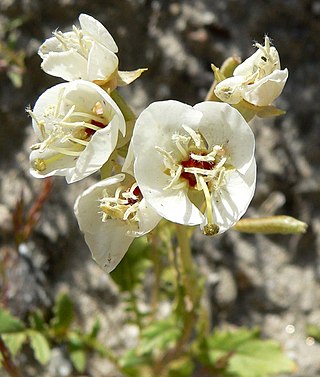
Chylismia claviformis is a species of wildflower known as browneyes or brown-eyed primrose native to North America. This species is found across western North America from the Pacific Northwest to northern Mexico.

Oenothera suffrutescens is a species of flowering plant in the evening primrose family known as scarlet beeblossom and scarlet gaura.

Clarkia davyi is a species of flowering plant in the evening primrose family known by the common name Davy's fairyfan, or Davy's clarkia. It is endemic to California, where it grows in coastal habitats such as beaches and bluffs. This is an annual herb producing a thin stem which grows along the ground or somewhat upright. It is lined with small oval-shaped leaves one or two centimeters long. While in bud the flower is enclosed in four fused thick sepals. It blooms into a petite bowl-shaped corolla of four pink petals which often have lighter bases. Each petal is 5 to 11 millimeters long.
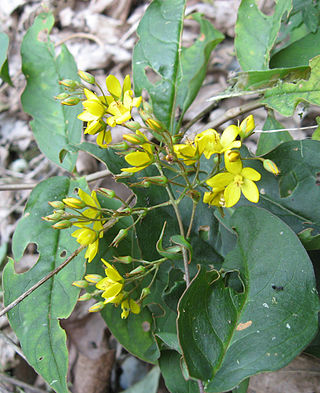
Lysimachia fraseri is a rare species of flowering plant in the primrose family known by the common name Fraser's yellow loosestrife. It is native to the Southeastern United States, where it is listed as an endangered species in several states.

Chylismia cardiophylla is a species of evening primrose known by the common name heartleaf suncup. It is native to the deserts of northwestern Mexico and the southwestern United States, where it grows in sandy and rocky areas in the desert scrub. It is an annual or perennial herb approaching one meter in maximum height, taking the form of a single erect stem or a low bushy plant. The leaves are up to about 5 centimeters long and are oval or roughly heart-shaped, with rippling or dully toothed edges. The nodding inflorescence is a dense bunch of flowers, each individual cup-shaped bloom on a stout pedicel. The flowers are yellow or cream-colored with petals 3 to 12 millimeters long, and generally remain closed during the day. The fruit is a capsule 2 to 5 centimeters long.
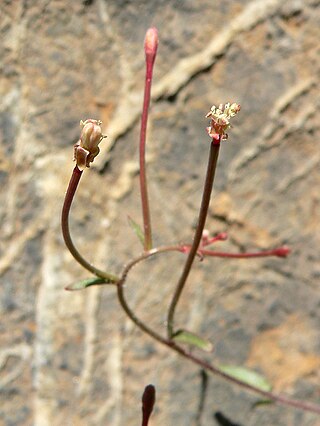
Eremothera chamaenerioides is a species of evening primrose known by the common name long-capsule suncup. It is native to the southwestern United States and northern Mexico, where it grows especially in desert regions. It is an annual herb producing an erect, hairy, glandular stem which is reddish in color and up to half a meter tall. The leaves are lance-shaped or oval and up to 7 or 8 centimeters long. The nodding inflorescence produces several flowers, each with white petals a few millimeters long and drying to dull red. The fruit is a capsule 3 to 5 centimeters long.

Camissoniopsis hardhamiae is a species of evening primrose known by the common name Hardham's evening primrose. It is endemic to California, where it grows in the chaparral and woodland of San Luis Obispo and Monterey Counties. It is a robust annual herb producing a hairy stem up to about half a meter tall. The leaves are lance-shaped to narrowly oval and up to 12 centimeters long. The nodding inflorescence bears flowers with yellow petals each a few millimeters long. The fruit is a cylindrical capsule up to 2.5 centimeters long containing several dark-colored seeds.
Camissoniopsis intermedia is a species of evening primrose known by the common name intermediate suncup. It is native to California and Baja California, where it grows on the slopes of coastal and inland hills and mountains, especially in areas that have recently burned. It is an annual herb producing an erect, hairy stem up to about half a meter in height. Most of the leaves are located in a basal rosette at ground level and are oval to lance-shaped and up to 12 centimeters in length. The hairy, nodding inflorescence produces flowers with yellow petals just a few millimeters in length. The petals have one or two red dots at their bases. The fruit is a straight or coiling, wormlike capsule up to 2.5 centimeters long.
Camissonia lacustris is a flowering plant species commonly called grassland suncup. It is an evening primrose endemic to California, where it grows on the grasslands of the Sierra Nevada foothills. It is also known from an area in the Northern Coast Ranges in Lake County.
Tetrapteron palmeri is a species of evening primrose known by the common name Palmer evening primrose. It is native to the western United States from California to Idaho, where it grows in several habitat types, including desert and sagebrush. It is a roughly hairy annual herb growing in a low patch on the ground, generally with no stem. The leaves are widely lance-shaped and up to about 5 centimeters long, with a few small teeth along the edges. The nodding inflorescence produces flowers with yellow petals only 2 or 3 millimeters long each and a noticeable bulbous stigma tip which may be up to a centimeter wide. The fruit is a leathery capsule around half a centimeter long with small wings near the tip.
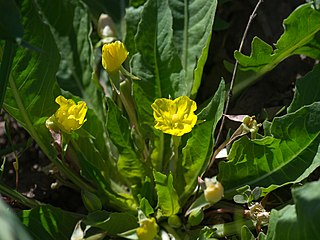
Taraxia subacaulis is a species of evening primrose known by the common name diffuseflower evening primrose. It is native to the western United States, where it grows in several habitat types, especially in mountainous areas. It is a fleshy perennial herb growing from a taproot and usually lacking a stem. The leaves are lance-shaped to oval and up to 22 centimeters long and are borne on long petioles. The flower has yellow petals, each up to 1.5 centimeters long, and a large, bulbous stigma tip. The fruit is a leathery capsule 1 to 3 centimeters long.
Clarkia borealis is a rare species of flowering plant in the evening primrose family known by the common name northern clarkia. It is endemic to California, where it is known from the forests of the southern Klamath Range and the southernmost Cascade Range foothills. It is an annual herb growing an erect, slender stem. The leaves are oval in shape and borne on short petioles. The top of the stem is occupied by the inflorescence, in which the lowest flowers open first and hanging, pointed flower buds occur at nodes at the top. The sepals separate as the flower blooms, revealing purplish pink petals. Each petal is between 1 and two centimeters long, elongated triangular to semicircular in shape, and sometimes flecked with dark purple. There are 8 stamens with anthers bearing blue-gray pollen, and a protruding stigma.
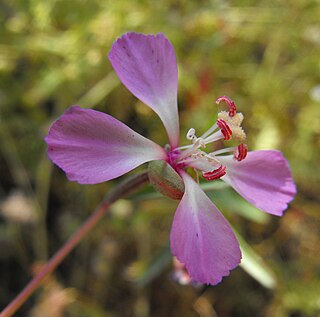
Clarkia delicata is a rare species of flowering plant in the evening primrose family known by the common names Campo clarkia and delicate clarkia. It is native to northern Baja California and adjacent San Diego County, California, where it grows in the woodland and chaparral of the Peninsular Ranges. This is an annual herb producing an erect stem just over half a meter in maximum height. The leaves are oval or widely lance-shaped, up to 4 centimeters long, and borne on very short petioles. The top of the stem is occupied by the inflorescence, in which the lower flowers open while the upper buds hang closed. The sepals remain fused as the flower blooms from one side. Each unlobed oval petal is about a centimeter long and pink to pinkish-lavender. There are 8 stamens, some with large orange anthers and some with smaller, paler anthers. There is also a protruding stigma with four large, fuzzy lobes.

Clarkia epilobioides is a species of flowering plant in the evening primrose family known by the common name canyon clarkia. It is native to California, Arizona, and Baja California, where it grows in shaded habitat in woodland and chaparral. It is an annual herb producing a slender, erect stem sometimes exceeding half a meter in height. The leaves are narrowly to widely lance-shaped and less than 3 centimeters long. The top of the stem is occupied by the inflorescence. Each hanging bud has four red sepals which remain fused all together or in pairs as the petals emerge during blooming. The petals are one half to one centimeter long, oval in shape, solid white or cream in color, often fading pink as they age. There are eight protruding stamens and one stigma.
Clarkia prostrata is a species of flowering plant in the evening primrose family known by the common name prostrate clarkia. It is endemic to the coastline of San Luis Obispo County, California, where it grows on seaside bluffs in forested and grassy areas. This annual herb is prostrate as opposed to erect as most other Clarkia species are. Its stems extend to a maximum length approaching half a meter and are usually somewhat fuzzy in texture. The leaves are oval in shape, up to 2.5 centimeters long, and lack petioles. The sepals of the flower separate into two pairs, revealing the lavender-pink blooming petals. Each petal is just over a centimeter long, fan-shaped to oval, and sometimes with a yellow base marked with a red spot.

Clarkia virgata is a species of flowering plant in the evening primrose family known by the common name Sierra clarkia. It is endemic to California, where it is known from the forests and woodlands of the Sierra Nevada.

Epilobium oreganum is an uncommon species of flowering plant in the evening primrose family known by the common names Grants Pass willowherb and Oregon fireweed. It is native to southern Oregon and northern California, where it is historically known mostly from the Klamath Mountains. It is currently confirmed to exist only in Josephine County, Oregon, and Trinity County, California, where it grows in boggy areas on serpentine soils. It is a perennial herb growing up to a meter in height with thin, hairless stems. The red-veined leaves are oval to lance-shaped and up to 9 centimeters long. The inflorescence bears flowers with pink petals just over a centimeter long and a protruding pistil. The fruit is a hairy, glandular capsule up to 4.5 centimeters long.
Epilobium pallidum is a species of flowering plant in the evening primrose family known by the common name largeflower spike-primrose. It is native to western United States, where it grows in moist areas in northern California, Oregon, and Idaho. It is an annual herb producing a narrow, upright stem up to 60 centimeters long lined with narrow oval leaves each up to 5 centimeters in length. The inflorescence atop the stem bears several flowers and hairy, leaflike bracts. Each flower has four bilobed petals each up to about a centimeter long and bright pink in color. The fruit is a beaked capsule between 1 and 2 centimeters long containing a row of tiny seeds.

Oenothera wolfii is a rare species of flowering plant in the evening primrose family known by the common name Wolf's evening primrose. It is native to the coastline of southern Oregon and northern California, where it grows in coastal prairie, dunes, and coastal forest and woodland habitat. As of 1997 it was known from only about 16 occurrences. The biggest threat to the plant is its easy hybridization with its relative and probable descendant, Oenothera glazioviana. As this rare wild plant crosses with the introduced garden escapee, introgression occurs, causing what is known as genetic pollution; fewer pure individuals of O. wolfii will be seen as they are outnumbered by hybrids.
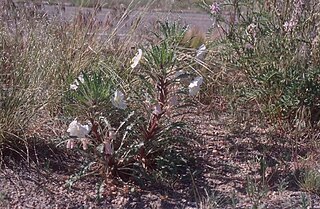
Oenothera harringtonii is a species of flowering plant in the evening primrose family known by the common names Arkansas Valley evening primrose and Colorado Springs evening primrose. It is endemic to the state of Colorado in the United States.














